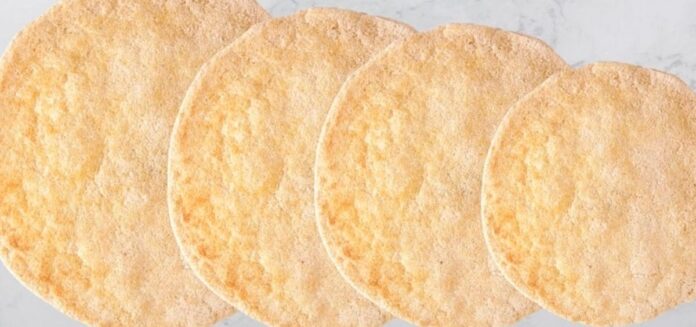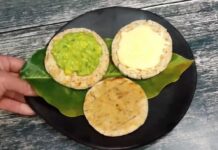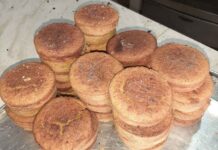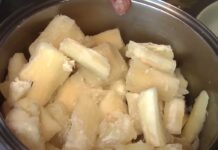
Receta de Casabe
El Casabe de yuca o cazabe es uno de los platos tradicionales más antiguos de las Américas; tiene su origen en las culturas indígenas del caribe americano, en Colombia este alimento procede de las etnias indígenas que habitaron y habitan la región de la Orinoquia o los llanos orientales, región que se comparte con la hermana república de Venezuela; te traemos una fácil receta de cómo preparar un casabe casero; y la receta tradicional que muchas etnias indígenas aun usan para su preparación.
Ingredientes
- 1 libra de yuca
- Agua
Preparación paso a paso
Preparación de receta casera de Casabe
- Quitarle la cascara a la yuca, luego limpiarla y lavarla con abundante agua.
- Luego se pasa a rallar la yuca con el lado más fino del rayador hasta que quede una masa de aquella yuca.
- Luego usa una pieza de tela limpia, preferiblemente algodón, para exprimir al máximo la masa y sacarle la mayor cantidad de agua posible.
- Luego pasas esa masa a una bandeja para hornear, allí distribuyes por toda la bandeja la masa y la guardas en la nevera por 4 horas, cada hora dentro de aquellas cuatro debes revolver y desmenuzar los grumos que vallan resultando.
- Luego la saca de la nevera y pasas a calentar un sartén antiadherente (preferiblemente una el sartén más pequeño que tengas) a fuego medio-bajo.
- Luego esparces un poco de la harina por todo el sartén para formar una capa fina, deja que se cuece por alrededor de un minuto y luego volteas al otro lado y también lo dejas que se cuece por un minuto, para asegurarte que este bien cocido observa que haya adquirido un color dorado, si tiene este color y se encuentra crujiente y se rompe fácilmente es que la preparación ha quedo lista.
Preparación de la receta tradicional de Casabe
- Se saca la yuca del Cocuno (Parcela de tierra con cultivo, generalmente de yuca), se limpia y se trasporta en el catumare (cesta artesanal).
- Se raspa la piel de la yuca hasta dejarla totalmente limpia y se hecha en agua limpia.
- Se procede a rayar toda la yuca hasta que quede una masa de la misma.
- La masa se deja reposar por dos días.
- Luego se procede al proceso de exprimir todo el líquido de la masa a través del Sebucán (Herramienta indígena para exprimir).
- Luego se saca del sebucán la masa seca y se empieza a cernir a través de un colador, para dejar la masa más fina.
- Esta harina se lleva al budare (una plancha de arcilla o hierro fundido) se esparce por todo el budare hasta que quede bien cocida, una vez este al punto voltea al otro lado y se espera a que este también en su punto para retirarse, y listo ya puede consumirse.
Video
Datos Curiosos
- El Casabe es libre de grasa y rico en fibra.
- El Casabe puede prepararse con Yuca dulce o brava (amarga); la que más tradicionalmente se usa es la amarga, pero debe prepararse con mucho cuidado porque esta contiene alta cantidad de cianuro.
- Este pan de yuca tiene una vida útil de hasta ocho meses.
- El Casabe puede usarse como un acompañante de muchos otros alimentos o comerse solo.
- El Casabe es un alimento de gran importancia para las culturas indígenas ya que en la época precolombina la Yuca junto al maíz eran uno de los grandes sistemas de cultivo de la época, al ser un alimento poco perecedero.
- Durante la época de la conquista muchos españoles usaron el casabe como provisión, gracias a que este alimento puede ser comestible durante mucho tiempo.
- Esta misma receta se utiliza para preparar el Mañoco el cual es una variación del Casabe.
- El Casabe es rico en vitaminas tipo B, que ayudan y protegen el metabolismo.
Fotos: Fundación Bigott y D.R Jorge Vera Fernandez.
Otras recetas que te podrían interesar
- Yuca frita
- Yuca cocida o hervida
- Tungos
- Tajadas de Plátano verde
- Tajadas de Plátano maduro
- Queso costeño
- Puré de papas o Naco
- Plátanos maduros asados con queso
- Plátanos en tentación o pícaros
- Plátanos calados
¡Comparte tu experiencia culinaria con nosotros!
Etiquétanos en Instagram con @el.rincon.colombiano o usa el hashtag #RecetasElRinconColombiano y deja que el mundo sepa qué tal te quedó esta exquisita receta.
¡Te esperamos con ansias para ver tus creaciones culinarias!





